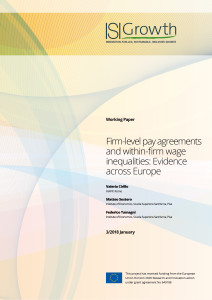This article investigates the relation linking single-employer bargaining – increasingly the norm in Europe – and within-firm wage dispersion – a significant driver of wage in- equality. The study considers six European economies (Belgium, Spain, Germany, France, the Czech Republic and the UK), featuring different collective bargaining institutions, in 2006 and 2010. The authors account for complementary aspects of wage inequality by measuring it both as the ratio between the 90th and the 10th percentile of within-firm wages, and the wage gap between managers and low-layers employees. The authors find that firm-level bargaining has heterogeneous effects across inequality measures and coun- tries, and also over time.
Firm-level pay agreements and within-firm wage inequalities: Evidence across Europe
INAPP
Matteo Sostero
Scuola Superiore Sant’Anna
Federico Tamagni
Scuola Superiore Sant’Anna

